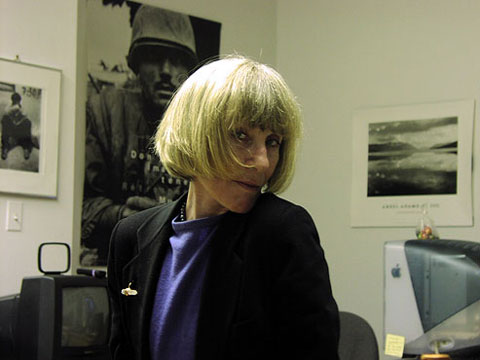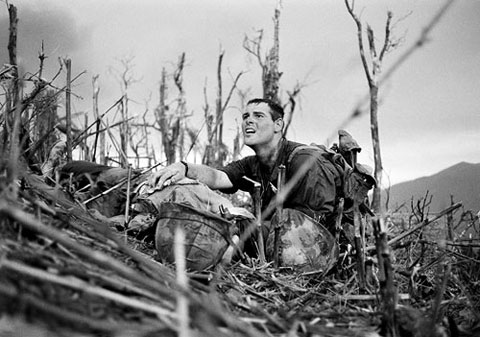She was thin, painfully so, someone who had trouble crossing a New York City street in the wind carrying her thin black portfolio case that acted like a sail blowing her the wrong way.
As a very young woman in the 1960s she had to be weighted down when she parachuted into the Vietnam War so she wouldn’t be blown away. She was 21, and had run away from France.
She came to live the rest of her life with shrapnel still embedded in her body, having been saved, she said, by her cameras that protected her physically from some of the worst of the mortars.
 |
|
| Catherine Leroy at the PixelPress office, March 2003 | © Zohar Nir-Amitin |
She liked traditional bistros with waiters in tuxedos and white tablecloths and champagne and older women feeding their poodles ice cream. She liked National Public Radio, and finding analyses anywhere that eviscerated the crazed policies of governments.
And, most importantly, she managed to document a piece of the craziness and guts and anguish that passes for war. To her credit some of her photographs were electric in their pain. And some still shock us today, when war has become more distanced, more colorful, less affecting.
A corpsman screaming over the death of his buddy. Marine crawls to rescue. Mother and wounded child. North Vietnamese sniper. She gave us no choice but to look.
She told me of singing loudly in French so that the Vietnamese waiting all around in ambush wouldn’t blast her and her companion to bits.
And she wanted the photographers who worked that war to have some respect even now, decades later.
She was old-fashioned that way, thinking that people who knew war and photographed life in so many of its manifestations should be called upon by society to give their opinions on the future direction of the world. To at least play a part.
She would gladly give the stage to others she respected, perhaps too shy, perhaps too modest, perhaps too unsure to take it all for herself.
And then she would explode in fury against those whose idiocies, whose banalities, whose acceptance of the conventional were not comprehensible to her in her quest to present her work and that of others. She could be aggressive beyond reason, lacerating with words even those who might actually have wanted to help.
 |
|
| Corpsman in anguish, 1967 | © Catherine Leroy |
On the other hand she knew and could observe the formalities of relationships, and could be enormously elegant. She also understood what it was like to have to struggle every month to pay the rent.
Her latest book would have been on the environment: “The Earth is Sick,” a collection of photographs by many from around the world, with writing by some of the most astute specialists. But no one was willing to publish it.
She was frustrated, angry, with few assignments, largely forgotten in today’s world of media, worried about her 91-year-old mother in France.
She hated many American policies, and loved Los Angeles, but always threatened to go back to Paris and never really did, except for visits. She drove a 1968 black Mustang with a white interior, loving the feel of the Pacific wind in her face, letting herself straddle both eras and a few continents.
Zohar, our designer, watched her sing a French song on a beach in Malibu to a dog named Friday that she had just met. She treated animals like children, and spoiled her cats.
She came from a generation of passionate witnesses, able to provide images to magazines like Look and Life and Paris Match that would sometimes publish them, connecting to a public interested and often moved by what the pictures had to say.
Catherine Leroy died last week.
She died, perhaps appropriately for her, after the 4th of July and before Bastille Day. It was four decades since she had run away to Vietnam.
In these last months she had been particularly frustrated, in a rush, angry at the people who she thought made it so difficult for her to do good work. Who would help her publish the book on the environment? Who would give her the means to do what she knew was right? One time she apologized for calling just to vent.
Last year she struggled for months, unsuccessfully, to put up a show at the Vietnam War Memorial in Washington, DC. There was to have been a panel discussion with writers and photographers contrasting the coverage of the war in Vietnam with the current war in Iraq.
She was still struggling, hoping that there would be a breakthrough, a chink in the media armor. For the world, it seemed, more than for herself.
Some of her pictures, as well as those of others whom she considered her colleagues, are on her site, Piece Unique Gallery.
In her absence, her photographs wander still.
July 11, 2006